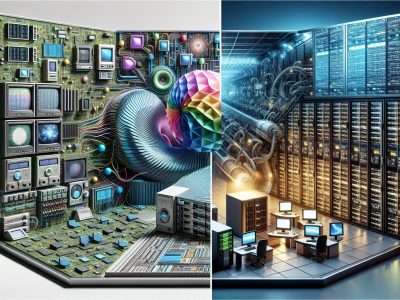Difference Between Standalone Software and Integrated Software: Key Features and Benefits
Picture trying to assemble a puzzle where each piece works perfectly on its own but doesn’t quite fit with the others. That’s often how standalone software feels—powerful yet isolated. On the other hand, integrated software acts like a symphony, seamlessly connecting various tools and features to create a harmonious experience. Both have their strengths, but how do you decide which is right for your needs?
Whether you’re managing personal tasks or running a business, understanding these two types of software can transform how you work. Do you value independence and simplicity, or do you crave efficiency through interconnected systems? The choice isn’t always obvious, but exploring their differences might reveal surprising insights that align with your goals.
Overview Of Standalone Software
Standalone software refers to applications designed to operate independently without relying on other programs. These tools focus on specific functions, delivering dedicated solutions for individual tasks.
Definition And Characteristics
Standalone software is a self-contained application that doesn’t require integration with other systems. Examples include media players like VLC and word processors like Notepad. Such software often excels in performing one primary task efficiently. You install, run, and use it directly without additional dependencies or external modules.
Key characteristics involve simplicity, ease of installation, and minimal resource usage. It typically offers limited scope compared to integrated systems but ensures reliability within its designated function.
Advantages And Limitations
Advantages include focused performance, lower costs compared to integrated suites, and user-friendly interfaces tailored for specific tasks. For instance, standalone antivirus tools secure devices effectively without needing extra utility bundles.
Limitations arise from isolation; these apps lack interoperability with other systems. Managing multiple standalone solutions can lead to inefficiencies when dealing with diverse needs requiring cross-functional data sharing or advanced synchronization capabilities.
Overview Of Integrated Software
Integrated software refers to a collection of applications designed to work together seamlessly. These interconnected systems share data and functionalities, providing a unified experience for managing various tasks.
Definition And Characteristics
Integrated software combines multiple tools into a single platform, enabling smooth communication between different modules. For example, enterprise resource planning (ERP) systems merge accounting, inventory management, and customer relationship management (CRM) functionalities.
Key characteristics include data centralization, modular design, and interoperability. Centralized databases eliminate the need for repetitive data entry across separate applications. Modular structures allow you to customize features based on specific requirements. Interoperability ensures that diverse components function as one cohesive system.
Advantages And Limitations
Integrated software enhances efficiency by automating workflows and reducing manual intervention. Shared updates across modules ensure consistency in information while saving time on repetitive processes. For instance, when sales data automatically reflects in the accounting module, it reduces errors.
But integrated solutions often involve higher costs due to licensing fees or implementation expenses. They may also require more resources like advanced hardware or skilled personnel for maintenance.
Key Differences Between Standalone And Integrated Software
Standalone and integrated software differ in their functionalities, customization options, costs, and maintenance needs. Understanding these distinctions helps you choose the right solution based on your specific requirements.
Functional Scope
Standalone software focuses on performing a single task or a set of closely related tasks efficiently. For example, VLC Media Player is designed solely for media playback without additional features like file editing or sharing. This targeted approach simplifies usage but limits functionality to its core purpose.
Integrated software combines multiple applications within a unified platform. Enterprise Resource Planning (ERP) systems exemplify this by integrating accounting, inventory management, and customer relationship management (CRM). Such solutions streamline operations across departments through centralized data access and interoperability between modules.
Customization And Flexibility
Standalone applications offer more straightforward customization due to their singular focus. You can often modify settings or add plugins to tailor them for specific use cases. But, integration with other tools might require third-party solutions or manual workarounds.
Integrated platforms provide broader customization capabilities through modular designs. For instance, ERP systems allow you to enable or disable features based on business needs while maintaining seamless data flow between modules. Yet modifying these solutions may demand specialized expertise and time investment.
Cost Implications
Standalone software usually incurs lower upfront costs since it’s developed for limited purposes and requires fewer resources to carry out. Freeware versions of standalone tools are also widely available but may lack advanced functionalities.
Integrated software involves higher initial investments due to its extensive scope and complexity. Licensing fees for ERP systems or similar platforms can be significant though they often lead to long-term cost savings by reducing inefficiencies across workflows.
| Cost Factor | Standalone Software | Integrated Software |
|---|---|---|
| Upfront Costs | Lower | Higher |
| Free Options | Widely Available | Rare |
| Long-Term Savings | Minimal | Substantial |
Maintenance And Updates
Maintaining standalone tools is simpler as updates typically address isolated features without affecting external dependencies. Many users find this predictable maintenance cycle convenient when managing individual applications.
Integrated systems require coordinated updates across all components which ensures compatibility among modules but increases complexity during implementation processes.. Regular system-wide upgrades improve performance yet demand careful planning to avoid disruptions in day-to-day activities—especially in large-scale environments relying heavily on integration benefits.
Factors To Consider When Choosing Between The Two
When deciding between standalone and integrated software, several factors influence the choice. Evaluating these aspects helps align software selection with specific requirements and goals.
Business Needs
Identify your operational priorities before selecting software. Standalone software excels in addressing individual tasks, like photo editing or document creation, without unnecessary features. For instance, graphic designers might prefer tools like Adobe Photoshop for focused functionality. On the other hand, integrated solutions streamline complex workflows by connecting multiple processes. ERP systems, such as SAP or Oracle NetSuite, unify accounting, inventory management, and CRM for businesses managing diverse operations. Choose integrated platforms if efficiency across departments is critical to achieving business objectives.
Budget Constraints
Consider both initial costs and long-term expenses when comparing options. Standalone applications often have lower upfront prices or free versions (e.g., VLC Media Player), making them accessible for limited budgets or personal use cases. But, managing multiple standalone tools may increase cumulative expenses over time due to separate licenses and updates. Integrated systems demand higher investments initially but reduce operational inefficiencies and offer bundled functionalities that save resources in the long run—especially for growing enterprises needing scalable solutions.
Conclusion
Choosing between standalone and integrated software depends on your unique needs, preferences, and long-term goals. Whether you value simplicity and independence or seek efficiency through interconnected systems, understanding these options helps you make informed decisions.
Evaluate the scale of your tasks, budget considerations, and the level of customization required. By aligning your choice with your priorities, you’ll ensure a smoother experience that supports productivity and growth in the most effective way possible.
- LVP Versus Engineered Hardwood: A Comprehensive Comparison - November 15, 2025
- Understanding Identity versus Role Confusion - November 15, 2025
- Xbox Versus PlayStation: A Comparative Analysis - November 15, 2025







